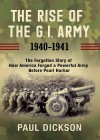Land Power Library - The Rise of the G.I Army 1940-1941
The Forgotten Story of How America Forged a Powerful Army Before Pearl Harbor
by Paul Dickson
Grove Atlantic, 2020, 416 pp
Paperback ISBN: 978-0-8021-5869-7
Hardcover ISBN: 978-0-8021-4767-7
E-Book ISBN: 978-0-8021-4768-4
Reviewed by: McLeod Wood
Paul Dickson has been a freelance writer since 1968 and has written historical works on American interwar slang (War Slang: American Fighting Words and Phrases Since the Civil War) and the Cold War (Sputnik: The Shock of the Century), to list a few. His most recent book, The Rise of the G.I. Army 1940-1941, focuses on the mobilisation of the US Army in 1940 and 1941 with an emphasis on the introduction of the draft and the impact of military manoeuvres on the army’s readiness. Dickson examines how the Great Depression set the scene for social reform in the mid-1930s and highlights the dire condition that the Army was in from a workforce and equipment perspective. His book is not a dry examination of mobilisation, rather, it incorporates elements of national policy, social reform, popular media, cultural events, and uses first-hand accounts to explain how the G.I Army was formed and trained.
Dickson begins his examination with a rude awakening. Just before 3am on Friday 1 September 1939, US President Franklin D. Roosevelt was awakened with the report that Nazi Germany, with its army of over 1.7 million men, had just invaded Poland.[1] In contrast to such a force, the US Army had a mere 190,000 personnel.[2] The task of bringing the military up to a standard sufficient to defend America and its citizens, against the armies marauding across Europe and East Asia, now fell onto the newly appointed Chief of Staff of the US Army – General George C. Marshall. Since 1933, the US Army had been responsible for the establishment, training, and maintenance of the Civil Conservation Corps (CCC), a Depression initiative of the Roosevelt Administration designed to enlist young and impoverished males to conserve, protect, and enhance the nation’s natural resources.[3] Marshall now set about using the skills his officers had gained through the administration of the CCC to “mobilize, organize, and administer an army of citizen soldiers”.[4]
As Europe succumbed to the rapid advances of the German Army in 1940, the importance of getting the United States’ own military posture on a firmer foundation became more pressing. On 16 October 1940, Roosevelt addressed the nation, announcing that “…16 million young Americans are reviving the 300-year-old American custom of the muster” though a peacetime draft (the Selective Service Act).[5] Dickson skilfully draws upon first-hand accounts of draftees to highlight how the draft touched all echelons of society, from the President’s son to elite baseball players, and ordinary citizens. In one instance, a new draftee personally sent General Marshall a steak that he deemed inedible (it was basically cardboard) to highlight the conditions of service; Marshall responded to the recruit’s commanding officer with direction to quickly improve the mess![6] Generally, the introduction of the draft proved challenging and the Army had to quickly adjust to new training methods and to build the infrastructure needed to support new units. By August of 1941, however, and in the shadow of the German invasion of Russia, a new challenge loomed. As their 12-month term of service was about to conclude, the Army was set to lose nearly 1 million draftees. Through the efforts of Roosevelt’s Party, in particular Speaker of the House Sam Rayburn, a bill was passed (203:202) to extend the length of Selected Service to 18 months.[7] The one million men in uniform were kept in uniform, and they would still be serving when on 7 December 1941 the Japanese attacked on Pearl Harbor. The draftees of October 1940, with the expectation of 12 months of peacetime service, would now serve for the duration of the war. This Act singlehandedly ensured the US Army was able to forge, and maintain, a power army before Pearl Harbor.
To train the new G.I. Army (and its draftees) for war service, the Army conducted large-scale manoeuvres between 1939 and 1941. The best known were the ‘Louisiana Maneuvers’ of 1941, which incorporated 19 divisions and approximately 400,000 men.[8] There were also large-scale manoeuvres in the Carolinas, Tennessee, California, Manassas, and Plattsburg. Marshall used these manoeuvres to focus the nation’s attention on weaknesses in material, doctrine, and leadership.[9] Photos of soldiers with wooden rifles or surplus equipment from the First World War were stark reminders to policy makers and industry that modernisation was required. For the troops involved, the manoeuvres emphasised mechanisation, logistics, air power, and individual skills. Eisenhower later wrote that the extraordinary truck and troop movements displayed in Europe during the rapid advance though France in 1944 was “…forecast on the roads in Louisiana in September 1941”.[10] The manoeuvres also elevated some commanders to prominence, such as Major General George S. Patton Jr. As commander of the Second Armored Division, Patton used the manoeuvres to demonstrate the effectiveness of shock action, firepower and manoeuvre on the modern battlefield. Patton benefited from headlines like “Tanks complete 2-day job in 7 hours”, and journalistic reports of his forces striking “with the full force of its thunderbolts to split the enemy lines”.[11] Patton’s demonstrated daring and competence during these manoeuvres secured his position within the Army and allowed him to avoid Marshal’s purges of non-effective officers. Most importantly, Marshall’s manoeuvres brought the G.I Army up to pre-combat preparedness and emphasised mass manoeuvre and logistics. These skills would prove to be invaluable in both the European, and Pacific theatres.
Dickson’s book, The Rise of the G.I Army 1940-1941, is a well-written, researched, and is an interesting insight into how the G.I Army was forged prior to the Japanese attack on Pearl Harbor. His arguments are supported by an interesting selection of photos from the era, contrasting horse cavalry drills and tank manoeuvres. Importantly, however, Dickson’s book contains an unfortunate oversight. While throughout his narrative Dickson acknowledges ongoing international events such as the invasion of Poland, the Battle of Dunkirk, the Battle for Britain, and the invasion of Russia, it does not explain how those events provided the strategic depth and time for the United States, and its G.I Army, to prepare for war. Without that strategic depth the 1939, the US Army of 190,000 men would have been very hard-pressed to either defend themselves against an existential threat or contribute to a land war in Europe or in the Pacific. It took time to rectify the Army’s numerical, equipment, and training shortfalls, though learning loops were quickened by observing ongoing operations by Britain and its Allies in Europe and North Africa, and by the Chinese Nationalists in Asia. As Dickson rightly points out throughout his book, it was a testament to changing political policy and the efforts of George C. Marshall that allowed the forging of a powerful G.I Army before Pearl Harbor.[12] Dickson’s book deals with history that is most relevant to those working at the strategic or operational levels within Defence and particularly within training or mobilisation areas. Beyond this readership, both Defence and civilian personnel will find nuggets throughout Dickson’s writing if they have an interest in understanding how the United States prepared for entry into the Second World War.
About the Reviewer
Lieutenant Colonel McLeod Wood (RAAC) is the Deputy Director of Indo-Pacific Operations at Headquarters Joint Operations Command. He has completed command appointments at the 2nd Cavalry and 2nd/14th Lighthorse Regiment’s and served in a wide range staff appointments at the tactical, operational, and strategic levels. He is a distinguished graduate of the United States Army Command and General Staff College and their School of Advanced Military Studies (SAMS). He has a particular interest in mobilisation and continues to research and write about the implications that major conflict may place upon our Defence Force.
Endnotes
[1] Paul Dickson, The Rise of The G.I. Army 1940 – 1941: The Forgotten Story of How America Forged a Powerful Army Before Pearl Harbor (Grove Atlantic: New York, 2020), 1.
[2] Dickson, The Rise of the G.I. Army, 5.
[3] Dickson, The Rise of the G.I. Army, 24.
[4] Dickson, The Rise of the G.I. Army, 42.
[5] Dickson, The Rise of the G.I. Army, 100.
[6] Dickson, The Rise of the G.I. Army, 129.
[7] Dickson, The Rise of the G.I. Army, 179.
[8] Dickson, The Rise of the G.I. Army, 190.
[9] Dickson, The Rise of the G.I. Army, 190.
[10] Quoted in Dickson, The Rise of the G.I. Army, 322
[11] Quoted in Dickson, The Rise of the G.I. Army, 158
Note: For those interested in further reading on pre-war mobilization in the US I would recommend the following:
- Christopher Gabel, The U.S Army GHQ Maneuvers of 1941, (Center of Military History US Army, Washington D.C, 1992).
- Peter Mansoor, The GI Offensive in Europe: The Triumph of American Infantry Divisions, 1941-1945, (University Press of Kansas, Lawrence, 1999).
- James Morningstar, Patton’s Way: A Radical Theory for War,(Naval Institute Press, Maryland, 2017).
[12]Note. The changing political policy referenced here is the slow but gradual shift from isolationism to interventionism.
The views expressed in this article and subsequent comments are those of the author(s) and do not necessarily reflect the official policy or position of the Australian Army, the Department of Defence or the Australian Government.
Using the Contribute page you can either submit an article in response to this or register/login to make comments.



